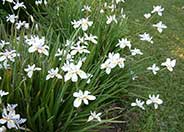
Common name:Southern Sword Fern
Botanical name:Nephrolepis cordifolia
Nephrolepis cordifolia is tough and easy to grow. This fern has bright green, narrow, upright fronds in tufts to 2'-3' tall. Fronds have closely spaced, finely toothed leaflets.

Common name:California Black Oak
Botanical name:Quercus kelloggii
The California Black Oak is a deciduous tree that grows 20'-60' tall. It has sharply lobed leaves which turn yellow to orange in the fall. The Black Oak is a California native, is drought tolerant, and attracts butterflies.

Common name:Netted Chain Fern
Botanical name:Woodwardia areolata
The Netted Chain Fern is a small fern that grows 2'-3' tall. It can tolerate full sun but does best in some shade. This fern is native to California and is drought tolerant.

Common name:Big Blue Lily Turf
Botanical name:Liriope muscari
Grass-like clumps of dark green leaves 1" wide up to 18" long are found on the Liriope muscari. It can reach a height of 12"-15", and dark blue flowers spikes can be seen held above the leaves during the summer. This is an excellent border, accent or ground cover plant that requires part shade exposure.

Common name:Mayten Tree
Botanical name:Maytenus boaria
The Mayten Tree is a slow growing tree that grows to 40' tall. It has weeping branches and dark green leaves. This tree can sucker in lawns and requires good drainage. It is drought tolerant.

Common name:Butterfly-Iris, Fortnight Lily
Botanical name:Dietes iridioides
This clumping evergreen Iris bears tall, narrow leaves to 30" tall and white flowers marked purple in the center on stalks up to 3' tall. This variety has stiffer, darker foliage than the bicolor form. It requires sun to part shade with little or no summer watering when established.

Common name:Lily of the Nile
Botanical name:Agapanthus hybrids
This evergreen ground cover/shrub will grow about 3' tall and has large green leaves with blue flowers (there is a white variety and dwarf varieties) that bloom in spring and summer. It will grow in all soils but prefers loam soil.
Designer: Verdant Landscaping
Photographer: GardenSoft
Physical weed control, including mulching, or hand removal protects the watershed from harmful chemicals.
Mulching and adding compost to soil can minimize evaporation and help soil absorb and store water.
Remove irrigation water and fertilizer from areas where you don't want weeds to grow.